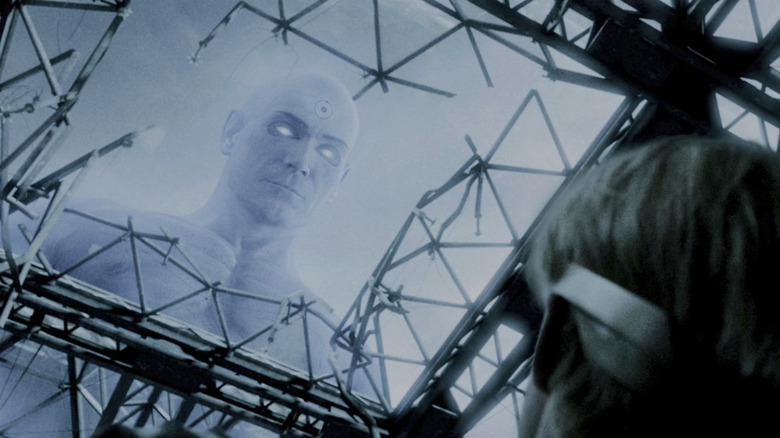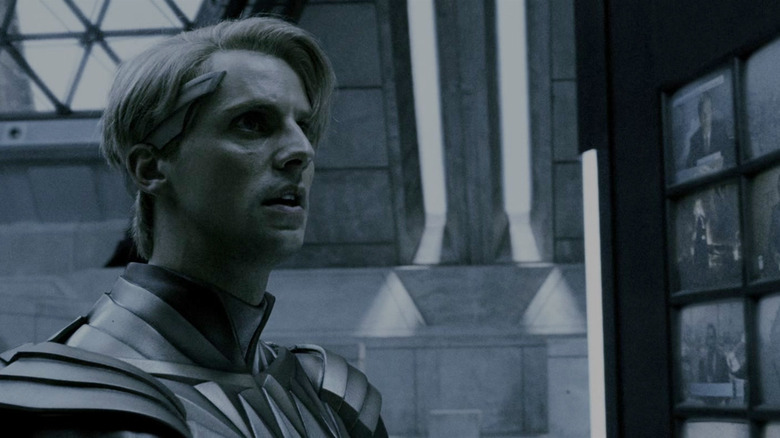The Watchmen Movie's Controversial Ending Wasn't Actually Zack Snyder's Idea
Warning: this post will contain spoilers for Zack Snyder's "Watchmen."
Alan Moore and Dave Gibbons' 1986 comic book classic "Watchmen" takes place in the then-present but also in a parallel universe wherein Richard Nixon is still president in the '80s. "Watchmen" took its cues from the superhero comics of the late 1930s while extrapolating history forward, asking what the world would look like if such fantastical beings actually came to be at that time. Naturally, conflicts like the Vietnam War would have ended differently, technology would have advanced by leaps and bounds ... and corruption would've still run rampant. Nixon, thanks to the positive outcome of the Vietnam War, was able to stay in office by repealing term limits. By 1977, however, public opinion had turned against super-vigilantes, and their existence was banned.
Moore and Gibbons were clearly making a comment on the rampant Reagan/Thatcher conservatism that was rolling high in the U.S. and England in the mid-1980s. If superheroes really did arrive on Earth in 1938, then only death and right-wing fascism would follow. "Watchmen" is a bitter, excellent work.
In 2009, director Zack Snyder adapted "Watchmen" to the big screen. The story and conceits were the same, but visually, the film was very, very different. Snyder recreated single panels from Moore and Gibbons' comic book, but added "glitz" to the drawings, making them into ultra-dramatic, slo-mo music video moments. Snyder's film was aesthetically sparkling, even though that look didn't exactly match the material.
Snyder's film also notoriously altered the ending of "Watchman" a little bit, and we'll get into details below. Screenwriter David Hayter, in an episode of the "Script Apart" podcast, pointed out that the alteration was not Snyder's idea, but was pitched second-hand by a friend of celebrated film director Darren Aronofsky.
Nixing the squid
At the end of both the comic and the film version of "Watchmen," the character Ozymandias (Matthew Goode) seeks to unite the world by orchestrating a devastating cataclysm that winds up killing millions of people. In the comics, his plan involves unleashing an extraordinary interdimensional squid monster in the middle of New York City. The squid dies, but not before causing untold deaths. In a twist, Ozymandias' plan works, and the Earth unites as one, declaring World Peace immediately, determined to stand against interdimensional threats. In another twist, most of Ozymandias' old super-teammates make their peace with his actions.
The film, already super high-concept and incredibly long (the theatrical cut of "Watchmen" runs 163 minutes), would likely have staggered under the weight of a giant interdimensional squid. Instead, the "Watchmen" movie ends with Ozymandias framing the superhero Doctor Manhattan (Billy Crudup) for all those deaths, which are caused by devices armed with Manhattan's energy signature. The cataclysm is different, even if the plot point is kind of the same.
Hayter also knew that an alteration was unavoidable, seeing as a sequence involving the destruction of a major New York metropolis would read differently in a post-9/11 world than it did back in 1986. In his own words:
"[W]e knew that it was going to be very difficult to do the ending of the book, and plus, since 9/11 had happened, we also, I didn't feel that we should have all those images of the dead bodies in Times Square, and I felt that that was not appropriate. So that inspired me to say, 'People should just be blown to shadows, like the Hiroshima shadows that are painted on the walls in the comic book.'"
The idea for the change came from a literal weekend when Darren Aronofsky was attached to direct "Watchmen."
The one weekend Aronofsky worked on Watchmen
For a moment, though, Hayter struggled with the Hiroshima imagery. He pitched his ending to Aronofsky, who ultimately had to turn down "Watchmen" to finish production on another film. As Hayer explained it:
"[A]t one point I had him using, like, a sun laser beam, which was a terrible idea, and just trying to figure out how to make this ending work. And at one point Darren Aronofsky was attached to direct for a weekend. Literally for a weekend. And I flew to New York for the weekend and we chatted about it. And when I came back Paramount said, 'Darren can't do it, we've got to get "The Fountain" finished,' and so on and so forth. So he stepped aside."
Aronofsky, however, talked about the script with a friend of his who worked as a professional physicist, and this unnamed friend thought up the plot idea that made it into the final draft. Hayter continued:
"[Aronofsky] sent me a note saying, 'I have a friend who's a physicist who had an idea for the ending of the movie.' And it was: what if Doctor Manhattan was the agent of destruction? And that just clicked into place in my brain and I was like, 'Of course that's what it should be.' There's only one element of supernatural magic in this story and it's Doctor Manhattan. So — and Adrian has been taking his energy to create, you know, clean energy around the world. So why couldn't he replicate it to make it look like Doctor Manhattan was destroying all these cities?"
It was a revelation, Hayter felt. And indeed, because Doctor Manhattan is the only character with legit superpowers, keeping the fantastical elements in his corner was logical.
Then he'll take Berlin.


